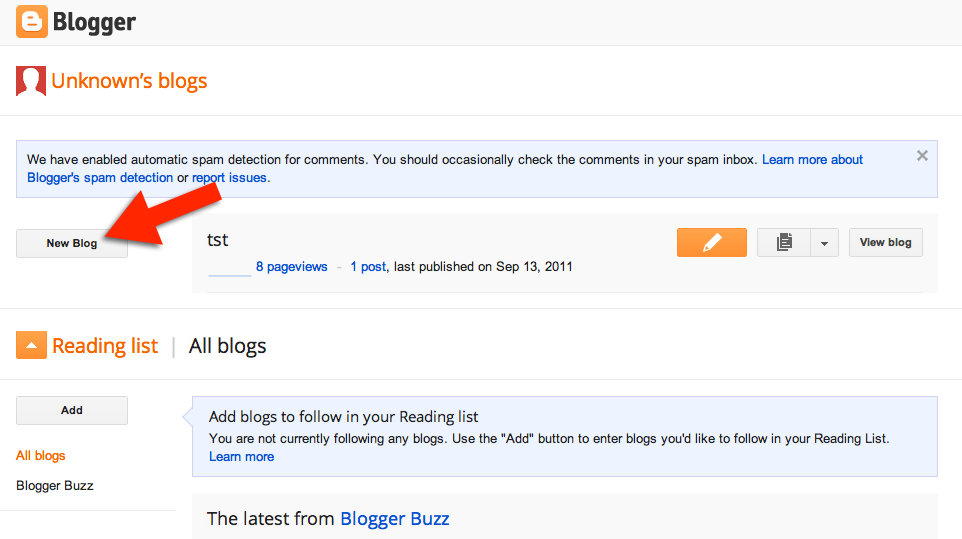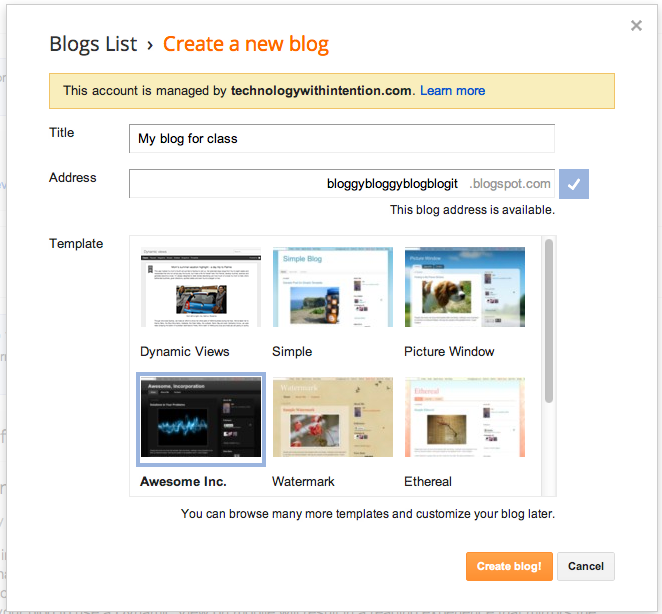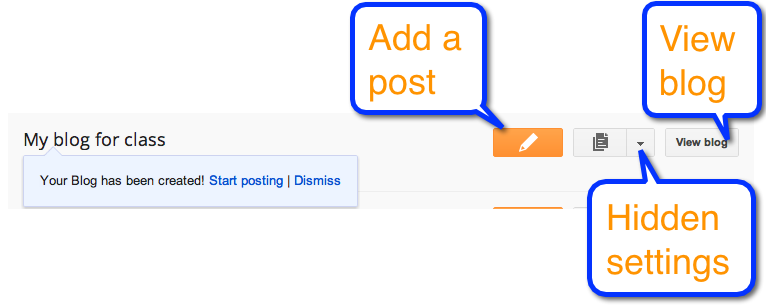This weekend I was playing around with iBooks and tried importing a few different file types for safekeeping. The app seems like a good place to store final versions of flat media that may be referenced in the future for a portfolio:
Category: tutorials
Tips and step-by-step instruction for using technology to teach effectively.
Create a classroom blog in under 2 minutes: updated
Back in April 2011 I wrote a quick post on how to get started with Blogger in your classroom. Google has since updated the user interface at Blogger, so this is an updated version of the instructions…and the process is even easier than before. Jump to the bottom of this post for a video walk-through, otherwise, here are the steps:
Start the clock, let’s build a blog:
0.00: Go to Blogger.com (Blogger.com is owned by Google. If you already have a Gmail account just login, otherwise you’ll need to add 45 seconds to create one).
0:12: In the webpage that opens, search for the “New blog” button and click it.

0:15: Add the title for your blog, create the URL (the address people will type to see your blog), and choose a template. Click “create blog!”

0:40: Click the “view blog” button to admire your new homepage.

0:50: Enter the blog settings via the drop-down menu and take a look around.
1:20: Sip a tasty beverage while your first brilliant post idea percolates.
1:35: Click the “new post” button to start adding content.
2 minutes? Really? Yes, really:
Free speech-to-text options for OSX & Windows 7
Will keyboarding skills go the way of cursive writing in this decade?
One of the primary obstacles to computing for many students is input. Speech-to-text capabilities, once available only with expensive software, now comes with the latest versions of the 2 most popular consumer operating systems, Windows 7 and OSX. Directions for activating speech-to-text are outlined below:
Windows 7
- Open Speech Recognition by clicking the Start button > All Programs.
- Select Accessories > Ease of Access > Windows Speech Recognition.
- Click the Microphone button to start the listening mode.
- Open the program you want to use or select the text box you want to dictate text into.
- Say the text that you want dictate.
Apple OSX (10.8)
- Open System Preferences from the Apple menu (top left) and click the “Dictation & Speech” panel.
- Via the “Dictation” tab, click “ON” next to “Dictation”
- In the resulting popup, select “Enable Dictation”
- Open any writing app or go to a text input field and double-tap the “fn” key to bring up Dictation.
- When little microphone popup appears, start talking.
- When finished, hit the “fn” key again or click the “Done” button.
iPad end-of-year turn-in process
Our school year (and first year as a 1-to-1 iPad program) is coming to a close. Going through the intake process for the first time, it seemed like it would make sense to share our process and the support documentation we’ve created:
Teacher prep
- Intake form for teachers – (https://docs.google.com/spreadsheet/ccc?key=0AnI8jre2u7V2dExXZ0ZKYjdwZEtBWTROYjFlMmtoOGc) – we used this to document what had been received. Google Docs was used so that our changes would remain synchronized as teachers worked to log each interaction.
- Turn in form for families (.pdf | .pages | .doc) – we provided and explained this document to parents and students at end-of-year conferences. Parents and students checked the devices out at the beginning of the year, it was only fitting to have both check iPads back in.
- Screen cleaner
- Computer wipes
- Tub/box for accessories
- Syncing computer with enough HD space to backup all devices
Student prep
For 2012/13, students will be issued the same iPads they used this year. In order to clear space for new apps and reduce back-up times, students were asked to organize the content they wanted and delete the multimedia that was consuming drive space. We provided time at school for cleaning up the iPad hard drives and had teachers on hand to help out with decision-making or procedural questions:
- Organize files
- Confirm that all files are named in a way such that you know what is inside before opening it
- Group Pages, Keynote, Numbers, Photos, Video & Garageband projects by subject/grade or some other system
- Delete any rough drafts of assignments that aren’t needed now that you’ve got a final version
- Visit Settings>General>Usage and take a screenshot of how much hard drive space is free/used
- iMovie
- Export completed projects to your camera roll
- Once that is complete, you can delete the iMovie project (which takes up lots of space)
- Head into the Photo Library and delete all the rough snippets used to create your master Movie, which is safely exported in its entirety to the Photo Library
- Other video
- Access the camera app
- Click on the little button in the bottom left that takes you to your photo library
- Use the top menu to show ONLY videos
- Delete any videos that are not needed any more AND were not final assignments
- Visit ShowMe & ScreenChomp to delete any files you don’t need any more
- Garageband – delete any practice tracks. Keep the stuff you love, dump the stuff you don’t.
- Photo Library – we typically take 100 photos at a time and get 2 decent shots. Delete the other 98
- Take another screenshot of Settings>General>Usage. Email both screenshots together in a single email to technology teacher
Intake process
- Students remove iPads from cases and cleaned them
- Teacher & student compare iPad to the signed turn-in form and agree on any damage
- Student reports any outstanding software or hardware issues (volume button doesn’t work, won’t hold charge, etc)
- Teacher logs the form and iPad turn-in on the iPad intake form
- Student turns in accessories – teacher notes on iPad intake form
- Teacher backs up all devices to laptop
- Teacher charges/drains all devices to 50% before powering down
- Proceed with warranty or Applecare claims on necessary iPads
- Secure functional devices until August prep
Gmail: Multiple Inboxes keep you informed
With a constant flow of email from teachers, parents and students, there is more than one time this year when I’ve been caught off-guard and/or let important communication fall through the cracks.
I’ve found it easier to stay informed since implementing Gmail’s multiple inboxes lab [editor note: George Polzer notes that this only works when Priority Inbox is switched off!!!], which uses filters to keep pertinent information “above the fold” when I’m online:
Multiple inboxes can be switched on from Gmail’s settings> Labs > Multiple Inboxes. Once enabled, you can set up inboxes using any search parameter you choose (or a combination using Boolean operators):
| Operator | Definition | Example(s) |
| from: | Used to specify the sender | Example: from:amyMeaning: Messages from Amy |
| to: | Used to specify a recipient | Example: to:davidMeaning: All messages that were sent to David (by you or someone else) |
| subject: | Search for words in the subject line | Example: subject:dinnerMeaning: Messages that have the word “dinner” in the subject |
| OR | Search for messages matching term A or term B* *OR must be in all caps |
Example: from:amy OR from:davidMeaning: Messages from Amy or from David |
| – (hyphen) | Used to exclude messages from your search | Example: dinner -movieMeaning: Messages that contain the word “dinner” but do not contain the word “movie” |
| label: | Search for messages by label**There isn’t a search operator for unlabeled messages | Example: from:amy label:friendsMeaning: Messages from Amy that have the label “friends”
Example: from:david label:my-family |
| has:attachment | Search for messages with an attachment | Example: from:david has:attachment Meaning: Messages from David that have an attachment |
| list: | Search for messages on mailing lists | Example: list:info@example.com Meaning: Messages with the words info@example.com in the headers, sent to or from this list |
| filename: | Search for an attachment by name or type | Example: filename:physicshomework.txt Meaning: Messages with an attachment named “physicshomework.txt”Example: label:work filename:pdf Meaning: Messages labeled “work” that also have a PDF file as an attachment |
| ” ” (quotes) |
Used to search for an exact phrase**Capitalization isn’t taken into consideration | Example: “i’m feeling lucky” Meaning: Messages containing the phrase “i’m feeling lucky” or “I’m feeling lucky”Example: subject:”dinner and a movie” Meaning: Messages containing the phrase “dinner and a movie” in the subject |
| ( ) | Used to group wordsUsed to specify terms that shouldn’t be excluded | Example: from:amy (dinner OR movie) Meaning: Messages from Amy that contain either the word “dinner” or the word “movie”Example: subject:(dinner movie) Meaning: Messages in which the subject contains both the word “dinner” and the word “movie” |
| in:anywhere | Search for messages anywhere in Gmail**Messages in Spam and Trash are excluded from searches by default | Example: in:anywhere movie Meaning: Messages in All Mail, Spam, and Trash that contain the word “movie” |
| in:inboxin:trash
in:spam |
Search for messages in Inbox, Trash, or Spam | Example: in:trash from:amyMeaning: Messages from Amy that are in Trash |
| is:importantlabel:important | Search within messages that Priority Inbox considers important. | Example: is:important from:janetMeaning: Messages from Janet that were marked as important by Priority Inbox |
| is:starredis:unread
is:read |
Search for messages that are starred, unread or read | Example: is:read is:starred from:DavidMeaning: Messages from David that have been read and are marked with a star |
| has:yellow-starhas:red-star
has:orange-star has:green-star has:blue-star has:purple-star has:red-bang has:orange-guillemet has:yellow-bang has:green-check has:blue-info has:purple-question |
Search for messages with a particular star | Example: has:purple-star from:DavidMeaning: Messages from David that are marked with a purple star |
| cc:bcc: | Used to specify recipients in the cc: or bcc:fields**Search on bcc: cannot retrieve messages on which you were blind carbon copied | Example: cc:david Meaning: Messages that were cc-ed to David |
| after:before: | Search for messages sent during a certain period of time**Dates must be in yyyy/mm/dd format. | Example: after:2004/04/16 before:2004/04/18 Meaning: Messages sent between April 16, 2004 and April 18, 2004.*
*More precisely: Messages sent after 12:00 AM (or 00:00) April 16, 2004 and before April 18, 2004. |
| is:chat | Search for chat messages | Example: is:chat monkeyMeaning: Any chat message including the word “monkey”. |
| deliveredto: | Search for messages within a particular email address in the Delivered-To line of the message header | Example: deliveredto:username@gmail.comMeaning: Any message with username@gmail.com in the Delivered-To: field of the message header (which can help you find messages forwarded from another account or ones sent to an alias). |
Google Earth update for iPad: kmz & kml files
Google Earth has long been one of my favorite desktop applications. When studying current events, students can “see” the part of the world that we are discussing and make connections to familial history, previous vacations and proximity to Seattle. Layers can transform Google Earth into a tool to support any lesson from climate & weather to history & innovation to language arts & culture.
Google Earth for the iPad isn’t as robust as it is for laptops/desktops, but the March 2012 release does offer a step forward with the ability to overlay .kml and .kmz files. This means a teacher or student can create custom content and then share this media with other iPad users via email or web links. So far it doesn’t seem that embedded video will play. I put together a quick demo of the new features:
Easily move iPad songs from Garageband to iMovie
Until the upgrade to iOS 5.1, the process of getting a song from Garageband to iMovie on an iPad was convoluted and involved syncing with a laptop or desktop.
iPad content creators rejoice – there is a new solution. While we can’t yet get Garageband compositions into iTunes, we can now drop them straight into iMovie creations.
A step-by-step walk-through of the process demonstrating how to get songs from Garageband into iMovie:
Google Reader Bundles: sharing work-around
Google Reader is a great resource for aggregating and sharing information. One of its most useful features for educators is the ability to bundle RSS feeds into a single information stream that can be subscribed to.
A few weeks ago @courosa mentioned online that the subscription button wasn’t working for user-generated bundles.

No word from Google about whether this is intentional or not. I did some digging within the code but couldn’t figure out what was going on. I took a look again today and think there is a solution that works: I’ve documented in a YouTube video for others to test:
Free tablet stylus hack
My students are always misplacing their styluses (styli?). Meredith Swallow, assistant for the Tarrant Institute for Innovative Education at the University of Vermont, explains how to use the conductive power of foil food wrappers to make a quick stylus.
Make sure your iPad has a screen protector on it before attempting.
Screencasting iPad app & web interface combination: EduCreations
This post is an introduction and evaluation of EduCreations new iPad screencasting app. This is a companion post to the previous reviews, Screencasting Apps for the iPad (September 2011).
Comparison to the common features noted in the previous article
- import a background image from the camera roll
- choose pen colors for drawing
- erase
areas of the screen orthe entire page - record voice along with what is happening on the screen
- upload for online viewing
1. EduCreations Interactive Whiteboard (free | iTunes link)
Pros
- Step forwards and backwards between edits.
- Move freely between slides while narration continues.
- Auto-pause the recording when attempting to add an image.
- Undo button steps backwards through changes.
- Dedicated image menu with image “lock” feature.
- Companion online screencasting interface.
- Online video sharing includes multiple levels of permissions.
- Video embeddable within other websites.
- Import and control multiple images per slide.
Cons
- Videos lives within the App or the propitiatory website by default.
- Embed feature requires FLASH (video won’t play on iPad or iPhone).
- No pen tip width control.